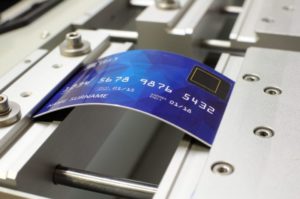 FindBiometrics President Peter O’Neill recently spoke with Dr. Hemant Mardia, Managing Director and CEO, IDEX. Thanks to its off-chip flexible sensor solutions, IDEX is a big name in the current biometric smart card market that is being pursued by the world’s leading fingerprint sensor companies.
FindBiometrics President Peter O’Neill recently spoke with Dr. Hemant Mardia, Managing Director and CEO, IDEX. Thanks to its off-chip flexible sensor solutions, IDEX is a big name in the current biometric smart card market that is being pursued by the world’s leading fingerprint sensor companies.
The interview begins with an overview of how IDEX’s technology varies from other fingerprint biometrics products on the market before delving into the biometric smart card market—the opportunities for biometric smart cards, the factors driving the massive interest we’re seeing in this arena, and how IDEX is capitalizing on it.
Read our full interview with Dr. Hemant Mardia, Managing Director and CEO, IDEX:
 Peter O’Neill, President, FindBiometrics: Can you please explain the differentiation between IDEX’s fingerprint sensor technology and others currently in the marketplace?
Peter O’Neill, President, FindBiometrics: Can you please explain the differentiation between IDEX’s fingerprint sensor technology and others currently in the marketplace?
Dr. Hemant Mardia, Managing Director and CEO, IDEX: Certainly. IDEX technology is what we call off-chip and what that means is that we decouple the sensing from the silicon processing. The advantage to this is really twofold: one is low cost and the other is flexibility and application. If we compare a typical fingerprint sensor with silicon technology, the whole of the sensor area is made out of expensive silicon, therefore the cost is proportional to the size of the silicon. Whereas with our sensor we have a very miniature piece of silicon which can be as small as five-times the size and then we sense in a low-cost material. For the second wave of fingerprint sensing it gives us huge flexibility.
FB: IDEX states that it’s ahead of the curve in cards; cards were a big topic in Barcelona at the Mobile World Congress, can you elaborate on this for us please?
IDEX: Why we believe that we are ahead of the curve in cards is that we have been working with the whole value chain in cards and this is about enabling the first biometric card system which can be mass deployed. What we have done is that we have created an adapted and customized sensor for cards usable in established infrastructure and manufacturing. Firstly, it works in an existing card infrastructure therefore it is compatible with existing terminals. Secondly, we work with card manufacturing processes and these are very distinct from standard electronics manufacturing. They have a different process, and what we have done is taken our flexible sensors that I mentioned with our off-chip sensing principle and we have created a polymer sensor that is thin and flexible and can be mounted into a standard card. Therefore we are creating a biometric card for the first time with standard manufacturing processes.
This is an activity that has been underway for us for about 18 months with partners across the ecosystem starting with a global payment provider and then working with card integrators such as Safran Morpho, which has been announced, and also working with enrolment solutions. So, it really is the full end-to-end solution that has been developed up to now.
As we speak, the card solution is being tested by end customer in real world trials. This is a significant event for us, and a strong testament to the maturity of our solution. We expect the trials to lead to certification and product launch in the second half of the year.
FB: I was over at the Safran Morpho booth at the Mobile World Congress and they were very excited to show me the new biometric payment card solution and I actually had a chance to try it so that was pretty cool. What are some of the other market opportunities in cards?
 IDEX: The initial focus and the business case for this program was financial inclusion, and this is really about such programs that benefits distribution in countries where the infrastructure hasn’t been developed for credit. So, it is a huge opportunity and that has been the principle volume application for us. But given the standardization of the solution, once we have created something that meets the EMV protocols in terms of security, meets the ISO standards in terms of durability and in terms of compatibility, then we believe this will scale well beyond financial inclusion. Therefore, banking clearly, identification, and access control, and even on to things like transit because you have the convenience of a biometric eliminating a PIN or a password but linked to a payment infrastructure. I think it is a really exciting opening and for me it is an inflection point in smartcards by creating something that is mass manufacturable and combined with what we have seen in mobile, tremendous user adoption and the familiarity with fingerprint biometrics. The two combined opens up the different verticals.
IDEX: The initial focus and the business case for this program was financial inclusion, and this is really about such programs that benefits distribution in countries where the infrastructure hasn’t been developed for credit. So, it is a huge opportunity and that has been the principle volume application for us. But given the standardization of the solution, once we have created something that meets the EMV protocols in terms of security, meets the ISO standards in terms of durability and in terms of compatibility, then we believe this will scale well beyond financial inclusion. Therefore, banking clearly, identification, and access control, and even on to things like transit because you have the convenience of a biometric eliminating a PIN or a password but linked to a payment infrastructure. I think it is a really exciting opening and for me it is an inflection point in smartcards by creating something that is mass manufacturable and combined with what we have seen in mobile, tremendous user adoption and the familiarity with fingerprint biometrics. The two combined opens up the different verticals.
FB: Well it is interesting that two years ago, this market didn’t really seem to exist and now all of a sudden it is gaining tremendous strength, what is driving all of this?
IDEX: Yes, I think that is really interesting. I first talked about it three years ago, and you are absolutely right, generally there was scepticism about the application and the use case. But, security has become such a major issue on a global basis and when you combine that with consumers seeing the incredible convenience of using a fingerprint on mobile, and I believe that has been done so well, then, the familiarity and the confidence and trust in such an application is there, and finally the cost effectiveness of putting a biometric with low power and low cost is what you need to enable a card. So, I think a combination of technology, consumer value and the widening of markets to look for more innovation in payments. It is a very clear convergence of those things. IDEX by having a very flexible and thin sensor is able to offer something that is attractive to the card manufacturers because they can see how they can incorporate into their existing manufacturing chain quickly. I feel the excitement is ramped up and we are seeing different smart cards like dynamic CVC and both types of use cases to give users more confidence in the fact that they have a transaction that is going to be secure and not be hacked into. I believe this is becoming important.
FB: So, it is like a perfect storm, isn’t it? A desperate need, a technology that is there at the right time, and then you layer in on top of that sheer convenience.
IDEX: Absolutely. I think it is just a great alignment, and for IDEX it is a really exciting opportunity, and as you said: a perfect storm and a perfect fit and our technology being literally flexible and literally thin, and what we are able to do with our sensor is integrate more of the electronics. I have definitely seen a real shift in the market demand and excitement for such a solution.
FB: Well I was certainly impressed with the demonstration that I was given at the Safran Morpho booth at the Mobile World Congress show utilizing your technology. Thank you very much Hemant for taking the time to speak with us today.
IDEX: Well thank you for your time I appreciate it and look forward to seeing you next time.


Follow Us